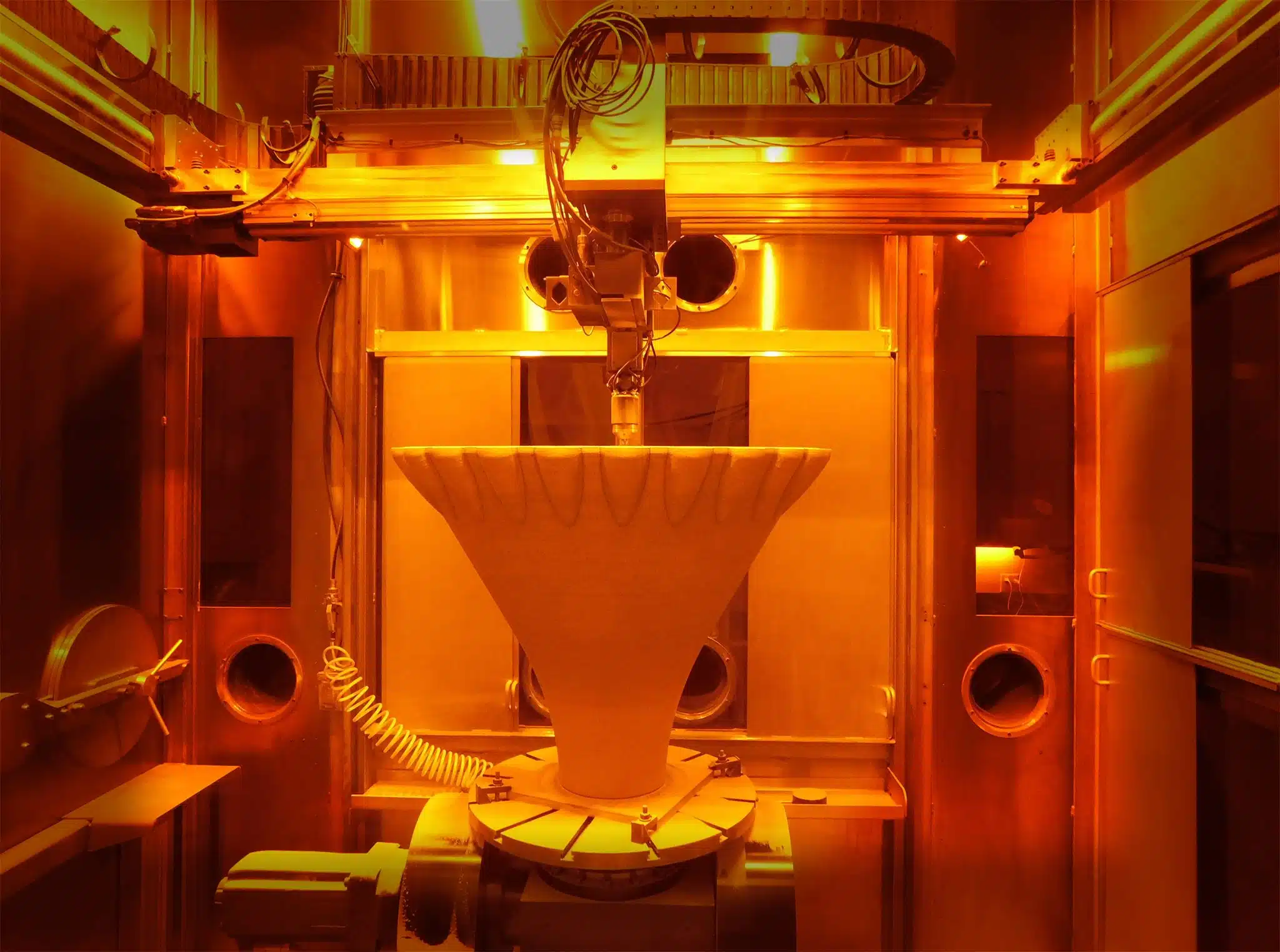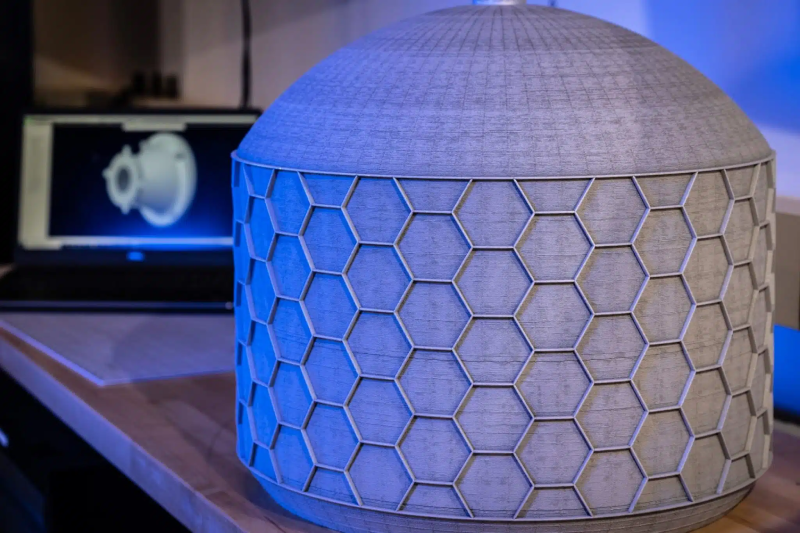In the framework of NASA's Reactive Additive Manufacturing for the Fourth Industrial Revolution (RAMFIRE) project, an innovative 3D printed aluminum rocket engine nozzle, created from a new aluminum alloy called 6061-RAM2, underwent rigorous testing at Marshall's East test area stand 115.
The nozzle faced substantial temperature gradients, with hot gases reaching temperatures of approximately 6000 degrees Fahrenheit. During combustion, ice formation was observed on the external surface of the engine nozzle.
This groundbreaking initiative, supported by NASA's Space Technology Mission Directorate (STMD), partnered engineers from NASA's Marshall Space Flight Center in Huntsville, Alabama, with Elementum 3D in Erie, Colorado. Their collaborative efforts resulted in the development of a weldable aluminum alloy that exhibits the necessary heat resistance for rocket engine applications. Aluminum, known for its lower density and the capability to produce lightweight, high-strength components, was previously limited in its use due to heat sensitivity and welding issues.
The RAMFIRE project revolutionizes rocket engine manufacturing by introducing 3D printed aluminum nozzles with small internal channels designed to maintain the nozzle's integrity in extreme conditions. Unlike traditional manufacturing methods that may require up to a thousand separate components, the RAMFIRE nozzle is a single-piece design.
This innovation significantly reduces the number of bonds needed and dramatically shortens the manufacturing process, setting the stage for deep space missions capable of carrying larger payloads.
 Production of a large-scale aerospike demonstration nozzle with integrated channels is currently underway at the RPM Innovation (RPMI) facility in Rapid City, South Dakota. This manufacturing process employs laser powder-directed energy deposition (LP-DED), where a laser creates a melt pool, and powder is deposited layer by layer into this pool. NASA engineers plan to utilize this nozzle as a proof of concept to guide future component designs. (Source: RPM Innovation)
Production of a large-scale aerospike demonstration nozzle with integrated channels is currently underway at the RPM Innovation (RPMI) facility in Rapid City, South Dakota. This manufacturing process employs laser powder-directed energy deposition (LP-DED), where a laser creates a melt pool, and powder is deposited layer by layer into this pool. NASA engineers plan to utilize this nozzle as a proof of concept to guide future component designs. (Source: RPM Innovation)
Collaborating with Elementum 3D, NASA initially developed the unique aluminum variant, A6061-RAM2, for constructing the nozzle and adapted the powder used in conjunction with laser powder-directed energy deposition (LP-DED) technology. RPM Innovations (RPMI), a commercial partner based in Rapid City, South Dakota, harnessed this groundbreaking aluminum and specialized powder to fabricate the RAMFIRE nozzles using their LP-DED process.
Paul Gradl, RAMFIRE principal investigator at NASA Marshall, stated, "Industry partnerships with specialty manufacturing vendors aid in advancing the supply base and help make additive manufacturing more accessible for NASA missions and the broader commercial and aerospace industry. We've streamlined the manufacturing process, enabling the creation of large-scale engine components in just a matter of days."
In line with NASA's Moon to Mars objectives, the novel alloy offers the potential to revolutionize rocket component production, creating lightweight yet robust components capable of withstanding high structural loads for missions into deep space.
John Vickers, the principal technologist for STMD advanced manufacturing, emphasized the critical importance of weight considerations for NASA's upcoming deep space missions. He noted, "Mass is a crucial factor for NASA's future deep space missions. Projects like this serve to advance additive manufacturing and advanced materials, which, in turn, contribute to the development of new propulsion systems, in-space manufacturing capabilities, and the essential infrastructure required for NASA's ambitious missions to the Moon, Mars, and beyond."
During the summer, at Marshall's East Test Area, two RAMFIRE nozzles successfully underwent a series of demanding hot-fire tests, employing liquid oxygen and liquid hydrogen, as well as liquid oxygen and liquid methane fuel configurations. These tests exceeded anticipated pressure levels, with pressure chambers exceeding 825 pounds per square inch (psi). The nozzles endured 22 starts and accumulated an impressive 579 seconds, nearly 10 minutes, of run time. This achievement demonstrates that the nozzles can function effectively in the most challenging deep-space conditions.
 Paul Gradl added, "This test series represents a significant milestone for the nozzle. Following a rigorous hot-fire test series, we've confirmed that the nozzle can withstand the thermal, structural, and pressure stresses required for an engine of lunar lander scale."
Paul Gradl added, "This test series represents a significant milestone for the nozzle. Following a rigorous hot-fire test series, we've confirmed that the nozzle can withstand the thermal, structural, and pressure stresses required for an engine of lunar lander scale."
Apart from the successful development and testing of the rocket engine nozzles, the RAMFIRE project has effectively harnessed the RAMFIRE aluminum material and additive manufacturing techniques to produce several advanced, large-scale components designed for demonstration purposes. These include a 36-inch diameter aerospike nozzle featuring intricate built-in coolant channels and a vacuum-jacketed tank designed for cryogenic fluid applications.
NASA and its industry partners are actively collaborating to disseminate the acquired data and the manufacturing process to commercial stakeholders and academic institutions. Numerous aerospace companies are currently assessing the innovative alloy and the LP-DED additive manufacturing process, exploring potential applications in the production of components for satellites and various other aerospace applications.